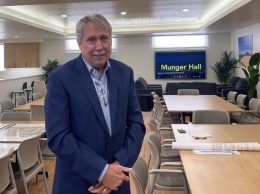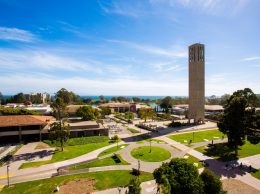UCSB’s ocean science center holds out hope for bright future

The project, which boasts some of the best views of the Channel Islands anywhere, has been much in the news lately because of a parting of ways between UCSB and contractor Melchiori Construction of Santa Barbara. That dispute, which culminated in UCSB terminating Melchiori on April 18, may or may not be headed for a showdown in court.
But officials told me that they expect to complete the first phase of the project near the end of the year, when about two dozen staff from the Channel Islands National Marine Sanctuary will move into their newly constructed office suite. A new contractor will be hired and work should commence in the next month or so said Ray Aronson project manager for UCSB.
Placing the marine sanctuary scientists who work for the National Oceanic and Atmospheric Administration alongside UCSB’s world-class ocean science faculty is just the first step in a construction project that’s eventually going to cost $25 million.
The overall project is expected to be a LEED Gold structure that uses a titanium heat exchanger to provide heating and cooling, tapping sea water already being utilized by the adjacent UCSB buildings. “It’s a very sustainable building,” said Aronson.
To fulfill the science and education mission that was the subject of a high-profile groundbreaking two years ago, it will take more money and more time. The jewel in the crown of the project is the second phase, the as-yet unfunded and uncompleted Outreach Center for Teaching Ocean Science, or OCTOS.
When the construction dust finally settles, the OCTOS center will boast a 25,000-gallon kelp tank, a mini-IMAX theater and an interactive learning environment that helps kids and teachers learn about the ocean. “OCTOS will be a perfect venue” for training teachers, Francis said, and it will spawn a number of Web-based activities for pre- and post-visit learning.
It also will be a great way to expose the UCSB campus to students from across California who have an interest in science. And it could spawn relationships with teacher education programs at other campuses in the region.
On May 18, I put on a hardhat and walked through the project’s shell with Francis, several area businesspeople and Steve Gaines, dean of the Bren School of Environmental Management, whose building is literally a stone’s throw from the construction site. Before he took the job at the Bren School, Gaines was on the ocean science faculty. And it was in large part his vision to put the sanctuary scientists on the UCSB campus and create a learning environment for students and teachers, all in the same structure.
Gaines, whose work on market-based solutions to fisheries management has earned him worldwide kudos, is pretty unflappable about the future of OCTOS.
So far the NOAA has provided about $8.1 million for the offices and learning-center design and UCSB has kicked in another $3.2 million for construction.
To finish the center, another $12 million from private donations is needed. Bob Ballard, the legendary deep-sea explorer and Bren alum, and, Titanic director James Cameron, a part-time resident of the South Coast, are deep pockets to be tapped. So far, nobody’s gotten their checkbook out.
Moreover across the Tri-Counties, there are other high-profile campus projects that desperately need funding.
Among them is an events center and athletic fields at CSU Channel Islands as well as scholarships to fulfill the Channel Islands mission of serving the Hispanic community in its targeted areas of Ventura and Santa Barbara counties.
California Lutheran University recently scored a $3 million grant to help expand its upward bound program for low-income and first-generation college students.
Oracle Chairman Jeff Henley’s recent gift of $50 million to UCSB won’t directly help the OCTOS fundraising but it will put the university on the map for being able to attract big pledges from heavy hitters.
The Lagoon Road project shows how tough it is to fundraise and complete visionary projects on time and in the post-recession environment. But with a little luck and some entrepreneurial fundraising, OCTOS could become more than just an empty shell.
• Contact Editor Henry Dubroff at hdubroff@pacbiztimes.com.











